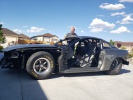Hey Everyone,
I have been going back and forth the past couple weeks hunting down miscellaneous issues with my swap and have finally gotten to the point I can focus on getting the VE table and tip in sorted out.
Engine is a 2000 4.8L with genIV rods and pistons with 799 heads, LS9 cam, 80lb injectors and a 78/75 turbo.
First thing is I finally settled to use "this" 80lb Siemens Deka data.
https://ls1tech.com/forums/pcm-diagn...ta-sticky.html
The reason why I say "this" data is because it seems like there has been dozens of posts for people asking for the data and I have found at least 5 different injector settings for these injectors. The post above seems to have helped the most so far.
I used 80lb for the IFR because I have my 1:1 regulator set to 43.5 with the vacuum line unhooked.
I also copied over the 0kpa row for Offset vs Volts vs VAC
I put the injector data into my file with my stock VE table and it ran very rich (11-12:1 at idle)
I then removed 20% of fuel from 400-2400 rpm and 15-105 kpa.
Idle seems better now BUT I am experiencing 2 issues;
lean spikes at tip i
as well as initial start up seems to stumble as soon as it is started and then settles about 5 seconds into running.
The post I referenced earlier mentions to "I'd leave the Fuel to Wall Transient stock. But if you notice any lean or rich conditions on throttle tip in, modify to this. The Min Fuel Mg or Transient Min Mg is a pulsewidth adjustment for idle. Do change this."
I did change the min fuel milligrams down to 0.016 from 0.041 which seems to have helped the idle to not be as rich.
I modified the Fuel to wall impact factor by a lot so far and it seems to still have a stumble. I focused on 120* and up and 40-100kpa.
So my question is how far do you normally have to modify these values by? Maybe experience specific to the siemens deka 80lb injectors if it matters.
I have increased the values by about 20% and still having a lean stumble.
Is it normal to have to put it 30-40%? Is the answer just keep increasing fuel in until its happy or is there something else going on that I am overlooking due to my ignorance.
Tip in is not an issue when it is warming up and under around 120* but it is also rather rich in that range.
One thing that I think is throwing me off is I did not get the engine all the way up to temperature first and do all of my testing at the same temp.
Can someone help kick me in the right direction.
tomorrow I will do a series of 4 or 5 tests all at the same temp to see if I can figure this out for sure but I don't want to waste a bunch of time modifying this value to try and make it as a band aid for a bigger issue.
I have also attached some files and data logs I took.
The "injector data from inj sticky" is the stock VE table and stock transient data.
The "updated transient" one has the 20% reductin in the VE table and ~20% increase in
Thanks everyone!




 Reply With Quote
Reply With Quote
